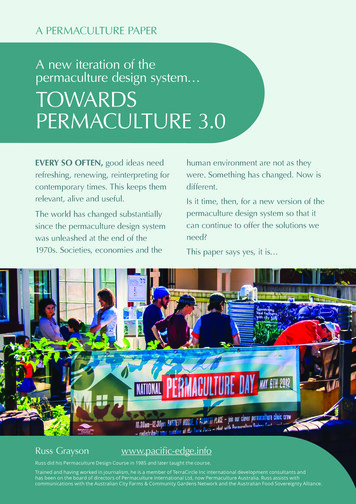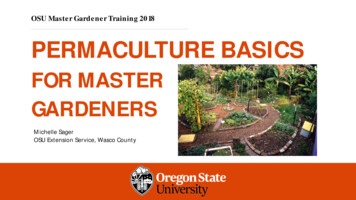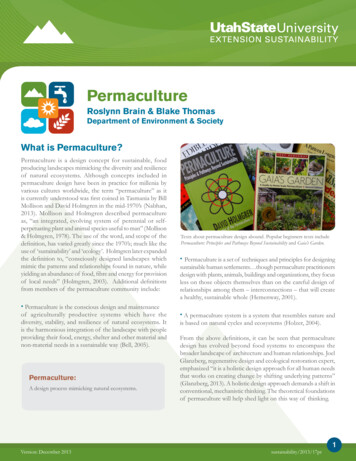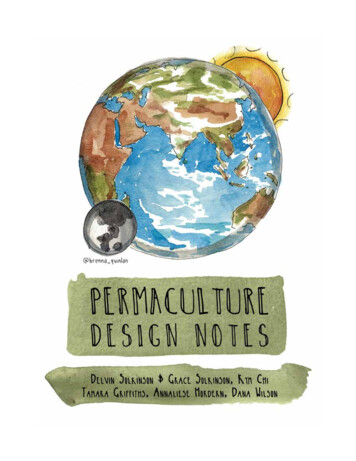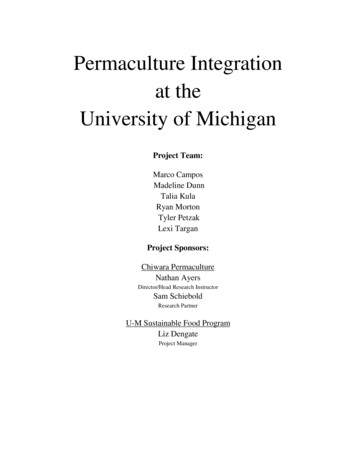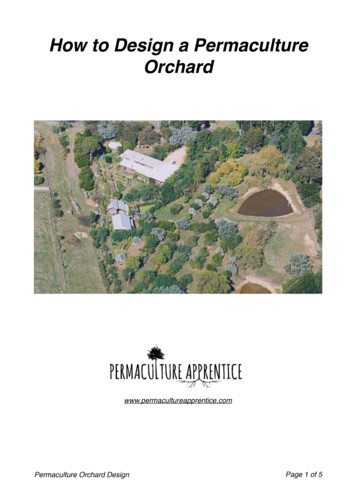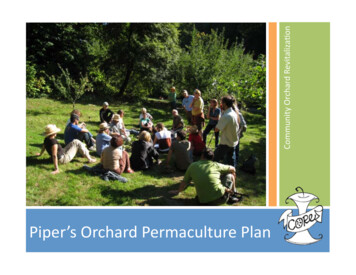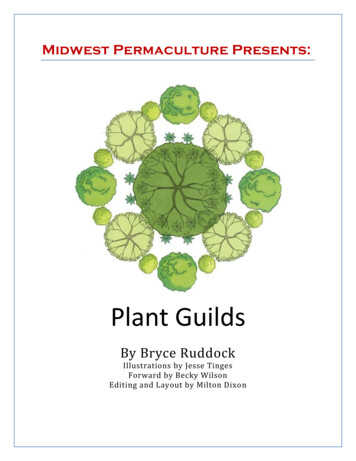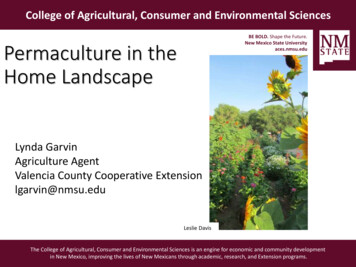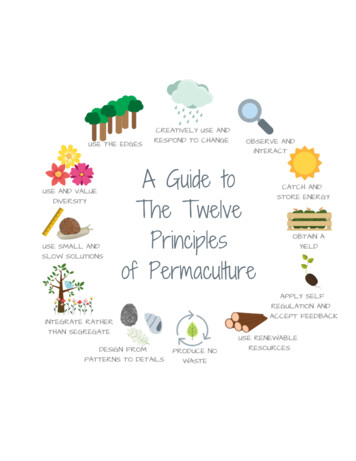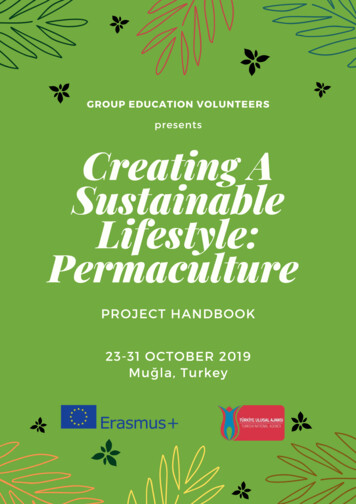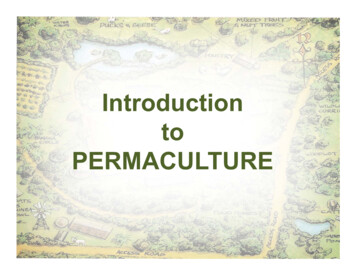
Transcription
IntroductiontoPERMACULTURE
My ALITYAESTHETICSCREATIVITYNEEDSPROBLEM SOLVINGCOMMUNITY BUILDING
PermacultureElements of a Total Permaculture DesignPermaculture is a DESIGN SYSTEM whichseeks to draw ideas from the universal principlesof nature (ecology).The way things work in nature canbe employed in human systemsto provide our needs withoutdegrading nature.
Our Food FutureLinear or sustainably cyclical?The modern, commercial agricultural miracle thatfeeds us and much of the rest of the world iscompletely dependent on the flow, processingand distribution of oil.The demand for food/oil continues to rise, while ourability to produce and transport it in an affordablefashion is about to drop.
Our Energy FutureEnergy descent from peak oil: collapse or evolution?
Food Prices vs. Oil PricesTen most recent years of world Food Price Index data from the UN Food and Agriculture Organization(FAO) and the monthly average oil price from the US Energy Information Agency (EIA).The correlation is practically 1-to-1.
Mollison and Holmgren
Permaculture EthicsBroad moral values or codes of behaviorCARE OF EARTH: Provisionfor all life systems tocontinue and thriveLIFE ETHICS:For people to have access to essentialresources needed for their existence andlives.FAIR SHARE:By paying attention to our real needs, we canset limits to population and consumptionand when we have excess, we can share withothers, including wildlife.
Permaculture PrinciplesA set of universally applicable guidelines which can be used in designingsustainable habitats. Distilled from multiple disciplines, these principles areinherent in any permaculture design, in any climate, and at any scale.1. Relative location2. Each element performs multiple functions3. Each function is supported by many elements4. Energy efficient planning5. Using biological resources6. Energy cycling7. Small-scale intensive systems8. Natural plant succession and stacking9. Polyculture and diversity of species10.Increasing "edge" within a system11.Observe and replicate natural patterns12.Pay attention to scale13.Attitude
Using PC Ethics & PrinciplesImplementing the earthcare ethics in our lives: Consider long-term consequences of your actions;plan for sustainability. Use native species or naturalized species knownto be beneficial. Cultivate small-scale, energy efficient,intensive systems. Plan diverse and polycultural systems that providestability and readiness for future social orenvironmental changes. Use everything at its optimum level; recycle all wastes. Work where it counts; assist those willing to learn.
Implementing the earthcare ethics in our lives: Increase the total yield by considering the sum ofsystem yields provided by annuals, perennials,crops, trees, animals, as well as energy saved. Use low-energy environmental and biologicalsystems to conserve and generate energy. Bring food-growing back into towns and cities. Assist people to become self-reliant; promotecommunity responsibility. Reforest the earth and restore soil fertility. See solutions, not problems.
Permaculture TreeThe idea of whole system ATER
The Principles in Practicework creates worksmall is beautifuleverything gardenseverything is a resourcedo only what is necessarynature thrives in diversitywhen in doubt, do nothingeverything works both wayspollution is an unused resourcework with nature, not against itthe problem is often the solutionobserve carefully before designingfunctions stack in hierarchical orderinclude repeat functions in designmake the least change for the greatest effectincreasing edges increases interaction & energyeverything gives to the surrounding environmentthe whole is worth more that the sum of its partseverything receives from the surrounding environmentevery element in a natural system performs many functionsthe yields of a naturally balanced system are theoretically unlimited
Permaculture is DesignConventional education pulls everything apart and looksat each element in isolation.Permaculture makes connections. It is a land use andcommunity planning philosophy that is based on howthings are connected.The focus is not on the elements themselves, but ratheron the relationships created among them by the way weplace them in the landscape. This synergy is furtherenhanced by mimicking patterns found in nature.
PermacultureElements of a Total Permaculture tsLAND &NATURESTEWARDSHIPLAND TENURE& COMMUNITYSocialComponentsLegal AidsPeopleCultureTradeFinanceBUILTENVIRONMENTTHE DESIGN:Harmoniousintegration oflandscape ructuresSourcesTOOLS &TECHNOLOGYCULTURE &EDUCATIONFINANCE &ECONOMICSHEALTH hics
Permaculture: Today“Consciously designed landscapeswhich mimic the patterns andrelationships found in nature, whileyielding an abundance of food, fiberand energy for local needs”VERTICAL GARDEN BY PATRICK BLANC, PARISTREMONT COMMUNITY GARDEN, BRONX, NYTHE HIGH LINE, NYC
Catch, Store, ReuseCycling energy through plants, animals, structuresSwales catch rainwater andstore it back into the soil.Catching a wild bee swarm andthe energy stored in honeyMany examples of wind andsunlight energy being cycled
Permaculture TechniquesObserve and apply patterns found in natureCreative use of waterDevelop aquaculturePonds in strategic areasIntegrate mammals andpoultry into the systemsIncrease edge patternsAdd mounds, berms, spirals,depressions, swalesWindbreaks to protect plantsRecycle waste from homeProduce animal foragesTechnological strategiesto support designPoultry as source offood, pest control, soilbuilding
Site AssessmentVital resources and considerations Water resources Regional climate (regional) Microclimate (local or site scale) Sun exposure Landforms Watershed characteristics Native plants Slope Off-site considerations
Site PlanningA gradual building up of systems
Permaculture TechniquesSmall scaleintensive systemsBuild soilfertilityUse what isthere alreadyUse perennial plantswhere possibleIncrease plantdiversity
Permaculture Techniques ExamplePlant stacking or“forest gardening”Develop plant“guilds”121.2.3.4.5.6.Canopy (large fruit & nut trees)Low tree layer (dwarf fruit trees)Shrub layer (currants & berries)Herbaceous (comfreys, beets, herbs)Rhizosphere (root vegetables)Soil surface (ground cover, e.g.,strawberries, etc.)7. Vertical layer (climbers & vines)37645The Forest Garden,(a 7‐layer guild)
Umass PC Garden
PRESENTERCynthia RabinowitzSoil Scientist, HGCONSOIL, , D. Permaculture: Principles &Pathways Beyond Sustainability. Hepburn,Victoria, Holmgren Design Services, 2002.Mollison, Bill. Introduction to Permaculture.Tasmania, Australia: Tagari Publications, 1997.CREDITSVisuals adapted for this presentation areattributed to their authors’ original usage:SLIDE 7:PC Tree from B. Mollison (Intro to PC).SLIDE 11: Adapted from D. Holmgren (P:PPBS).SLIDE 15: Adapted from D. Holmgren(www.futuresecenarios.org)SLIDE 16: Food Price vs. Oil Price graph by PaulChefurka (www.paulchefurka.ca)SLIDE 19: Quirindi Public School PC Plan byNick Ritar (www.milkwood.net/)SLIDE 21: Adapted from diagram by Graham Burnett(http://en.wikipedia.org/wiki/Forest gardeningSLIDE 23: Adapted from B. Mollison (Intro to PC).SLIDE 24: Diagram/photo by Graham ngSLIDE 25: PC Plan, by B. Mollison (Intro to PC).PRESENTATION DESIGNMarianne GrecoApril 2011
Permaculture is Design Conventional education pulls everything apart and looks at each element in isolation. Permaculture makes connections. It is a land use and community planning philosophy that is based on how things are connected. The focus is not on the elements themselves, but rat
